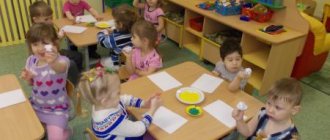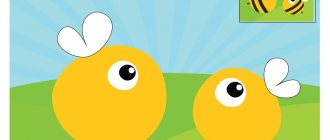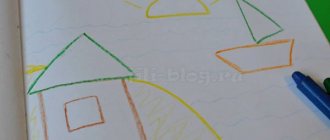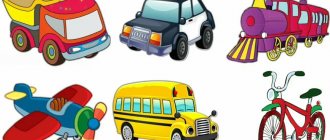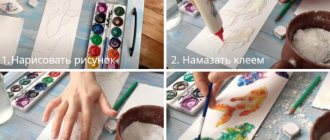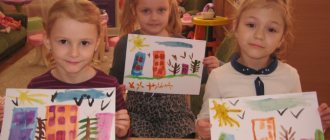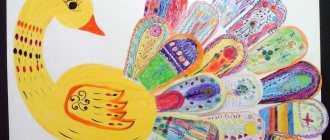Drawing for a child is not only a useful and exciting skill, it is a way to express their personal “I”.
Although some parents do not see the point in children's scribbles, the first drawings indicate the functioning of the brain and teach the baby to think and analyze. The benefits of drawing for children are a scientifically proven fact, repeatedly confirmed by parental experience.
Teaching drawing to a child 2-3 years old
You need to get the most out of the image. The child first draws with vertical, wavy lines. He still has difficulty coloring objects.

First line technique
First you need to introduce your child to drawing subjects. The hand should hold the pencil correctly, the brush should be rinsed in a glass of water. The best way to learn is through demonstration. You can sit down at the table next to your baby, take a pencil and start drawing your drawing, or try to control your child’s hand. You need to take more paper to spread it all over the table.
Important! It should be understood that drawing with children 2-3 years old starts small. To begin with, you need to be content with incomprehensible lines.
The benefits of drawing for child development
Drawing helps you understand the world faster, but this is not the only advantage of such activities, there are others:
- development of fine motor skills of the hands. At 2 years old, the baby learns to hold objects and direct them correctly. Children become smarter and their speech develops faster. Psychologists describe the presence of reflex points on the fingers, from which the signal enters the brain. From their stimulation mental abilities develop;
- the emergence of purposefulness;
- figurative thinking. In the future, for memorization, it is important to associate objects with images;
- emphasizing attention and imagination;
- development of mathematical abilities and logic. Shapes of objects, comparison, equality - these are simple concepts in mathematics that are ingrained in childhood.
At what age should I start?
There is no need to rush the event. Experts recommend introducing a baby to drawing from the age of eight months: by this time the child can sit confidently. It is advisable to start with finger paints and a large sheet of paper. You need to be prepared for the baby to get everything dirty.
Some psychologists believe that teaching children to depict real objects: clouds, trees, houses, geometric shapes is not recommended until the age of 8, so as not to discourage the little artist from wanting to draw.
It should be understood that preschool children convey their visual and tactile sensations from the object in the drawing. They are not interested in the similarity of the object. The period of doodle drawing has its own stages and at this time it is important to prevent the baby from blocking this process:
- chaotic scribbles (up to a year) . This is the time when a child just picks up a pencil, pokes it at a piece of paper, rejoicing that traces remain there. Parents should provide feedback to the baby, reacting positively to his creativity;
- circular scribbles (1-2 years) . Now the baby realizes that he can control his movement and actively draws circles, lines, and squiggles. At this stage, parents are tempted to teach their child to draw correctly: a square house, a round sun. Such actions block the child’s imaginative thinking;
- advanced doodles (2-3 years) . This is the last period of “pre-fine” drawing, in which the baby discovers that there is meaning in the circles, dots and curved lines he draws. The process should bring joy to the child: in order to maintain the child’s self-esteem, parents should even hang doodles on the wall, admire them and proudly show them to friends.
Realistic appearance of objects appears in children's drawings only by the age of 7-8 years. It is during this period that the child has a desire to evaluate an adult in order to achieve a better result and the question arises about the need to continue studying at an art school.
How to interest a child
In any business, the most important thing is interest. You can get used to drawing if your child loves it. There are several ways:
- Emotional perception of an adult. The parent should praise and rejoice. Through the emotions of an adult, you can achieve success in drawing a child.
- Turn the lesson into a game. You can come up with a game plot that will be interesting to the baby. For example, a bunny asks for a carrot, you need to draw it. The game should be filled with meaning. You can conduct a dialogue, show the child a toy hare.
- Process. We must not forget about the most important thing. The first drawing will definitely impress the little one, so there should be a lot of different paints, pencils, and felt-tip pens on the table. Many new objects are the main attribute of the first “picture”. The second and third pictures will be even better.
Lesson on FEMP and parental consultations in preparatory groups
What to draw on?
Most often, children are offered A4 sheets. This is a fairly budget option, taking into account the fact that a child can draw one line with a brush across the entire sheet and demand a clean one for a new “plot”. But it will be great if the drawing lesson is held on a large sheet of whatman paper laid out on the floor. “Large drawing” is very useful for a child. He is still just mastering the world around him and the “ways of influencing” it. It is quite possible that he will want to paint himself. Or walk with your decorated feet on the floor, while experiencing extraordinary delight.
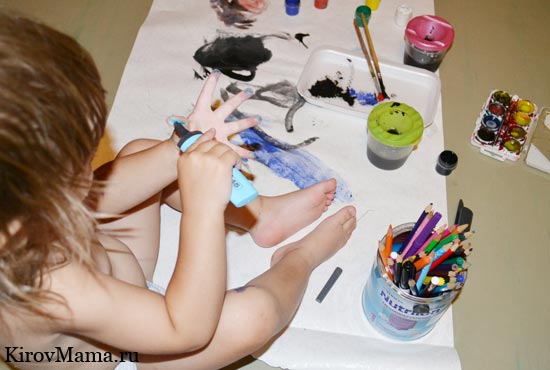
Instead of expensive sheets of whatman paper, you can use a roll of cheap white paper wallpaper.
In addition to paper, you will have to stock up on: sippy cups (sometimes you can set out larger dishes with water), a palette for mixing paints. It will be very good if you have a double-sided board in your house (on one side you can draw with chalk, on the other with markers).
Image techniques
To understand how to teach a child to draw at 3 years old, you need to consider drawing techniques. From a variety of options, you can choose the most effective ones for your baby.

Poking technique
- Poking drawing. The adult selects the plot of the template that needs to be supplemented. It is recommended to choose a semi-dry, hard bristle brush with gouache paint. A felt-tip pen will also work. You can color a snowman, animals, plants. This technique will help you learn how to color.
- Dipping. For this method it is better to choose paints. The child holds the brush diagonally closer to the table (in the vertical poke technique) and leaves brush marks. These could be tracks of an animal, lights on a Christmas tree, patterns on clothes. You can print a black and white picture or draw it yourself.
- Fingerprints. Apply a little paint to a white sheet and show how to paint with your fingers. You should be careful when choosing paints, because babies’ skin is very delicate and susceptible to allergies and irritations. You should choose gouache and watercolor.
- Drawing with lines. This is a more complex stage that needs to be introduced after studying the first three techniques described above.
Paints
Two types of paints are relevant for children: watercolor or gouache. Some people get used to one type, while others like others. In any case, you need to try to understand.
As for watercolors, few recommend it as the first paints, although modern manufacturers produce sets designed specifically for the little ones (the so-called honey watercolor). These are safe water-soluble paints that are suitable as the first ones. They are based on no toxic substances, given that a child may accidentally lick the brush. Good for coloring and economical.
Gouache should be chosen from the age when the child stops putting everything in his mouth (gouache is not one of those paints that can be tasted). Painting with gouache is pleasant if you choose the right brand (by the way, we always bought gouache from Gamma or Luch and did not regret it, but in both series, according to reviews, there are cheap sets with dirty shades). Low-quality paints will not fit well on paper and mix unsightly, sometimes forming sediments and clumps, which will definitely discourage you from painting with gouache. So make your choice responsibly.
Other types of paints (acrylic, tempera, oil) are considered more professional and are not recommended for children at first.
Workspace organization
The workplace should both attract and teach organization.
- First you need to take care of the child's health. The table and chair included must be adjusted to the height of the child. The back is rigid for correct posture. During work, you need to monitor his body position, carefully guide him without knocking him out of his work.
- Interesting design. It’s always nice when your child’s desk matches the interior of the room, but you shouldn’t forget about visual perception. The workplace should attract the little one.
- Before drawing with children 2-3 years old, you need to prepare a table. It is advisable to do this in front of a child. Carefully laid out paints and pencils will teach him order. After classes you need to clean everything up. Again, you can come up with a game that will teach your child to keep order, then in the future during school lessons he will keep his workplace clean.
How to teach a 3 year old child to draw
The first image should interest the child so that next time he starts drawing again. To teach a 3-year-old child to draw, you can use one of the techniques.

Hatching on coloring books
- The coloring technique will help your child choose the right colors. You need to help him not go beyond the line by coloring two or three objects yourself. You need to start with simple coloring books: a house, a car made of shapes, a flower.
- Technique of improvised means. You can try drawing with toy vehicles or threads. You can lay out patterns with them and then paint them.
- Drawings that develop mathematical skills: lines, ovals, circles. These can be provided as templates. For example, a drawing of a boy with colorful balls.
Lessons of traditional and non-traditional drawing in kindergarten
Markers
One of the favorite materials for any child: they leave a bright mark and do not require special pressure. And in our childhood, these were some of our favorite materials for drawing due to their color palette.
The disadvantage of regular felt-tip pens is their durability on various surfaces (for example, on walls), so for children under 3 years old it is better to choose washable felt-tip pens. But the cost of these will be much higher than usual.
Choose the color palette as you wish: some parents prefer to go with more expensive ones, but with fewer colors, while others prefer a variety of colors. But to prevent both markers from drying out, you need to teach your child to always close the caps.
Felt pens for little ones usually have a triangular cross-section (for easier grip) and a rounded tip of the rod.
As for the paper, regular printer paper will also work, but fresh markers can leak onto the other side, so you need to put something under the paper to prevent the table surface from staining.
For older children, you can try buying art markers (a modern material based on alcohol and pigment), which are considered a more professional material.
Interesting drawing ideas
Interesting image options can give the child more knowledge. Choosing the right coloring book is the responsibility of the parent.
You can make your own coloring in the form of the seasons, combining all the image techniques.
- autumn: dipping technique for colorful leaves;
- winter: poke technique for the New Year tree. A winter landscape provides many ideas (a snowman for understanding shapes, sports equipment for introducing activities);
- spring: dipping technique for drawing buds and first leaves;
- summer: understanding shapes (ice cream), drawing with a poke (flowers).
What topic to choose
Parents often have questions about how best to draw: painting objects step by step or first seeing the finished result. It is difficult for a child to select exact colors for objects, so it is better to initially demonstrate how, for example, a flower should look, and then complete the drawing step by step.
Note! The topic must relate to real objects. No need to start with coloring pages of non-existent cartoon characters. You can even show off the item for the image first.
Drawing with fingers and palms
Children may be interested in hand painting. Using this technique you can depict flowers and the sun. The method is very easy, since no additional items are needed for the lesson.
For your information! There are special finger coloring books on sale.

Picture of palms
Pencils
Another material that not everyone likes. Compared to oil-based crayons, pencils are harder and require effort to achieve rich, vibrant color. But, of course, in order to decide which material is most convenient for your child to draw with, it is still worth buying the first pencils.
Choose soft triangular ones with a small number of colors in the set (12 colors are enough to decide whether you like it or not). Some manufacturers produce special sets for the smallest: they are triangular, with an increased diameter and with a large rod.
Should I send my child to a drawing class?
The optimal age for a child to study in a circle is 4-6 years. Your baby's social communication skills should develop gradually.
Important! A sudden introduction to a group of guys can be stressful for him. There is no need to rush into learning; the basic basics can be learned at home.
Recommendations from psychologists and teachers
Psychologists note the importance of feedback between adults and children. Drawing not only gives certain skills, but also brings parents and baby closer together. Teachers advise starting with coloring books so that the child remembers the object itself. It is still difficult for him to depict a flower that he saw on the street once. Simple lines can also be the goal of drawing for children 2-3 years old.
The first “picture” for the baby is a step towards a complex activity. It is useful to develop drawing skills to improve mental abilities. When choosing basic techniques, you need to choose the most suitable and interesting one for the child. Don’t forget about personal contact with the baby, then drawing will not just be a lesson, but will develop into a hobby.
Finger paint
It may be hard to believe, but not all kids enjoy finger painting. The strange jelly-like consistency, which stains both hands and everything around, is not suitable for every child. But oddly enough, psychologists recommend starting your acquaintance with drawing with fingertips.
Of course, for the sake of experimentation, you can buy safe finger paints for a one-year-old baby to introduce him to colors and textures, but very rarely do any children become interested in this material.
You can draw on any surface, especially if you bought washable paints, but it is better to immediately let your child know that a separate surface is intended for drawing. Specifically for finger paints, choose larger formats (for example, cut sheets of whatman paper into A3 and A2 formats). You can also try paper on a roll.

